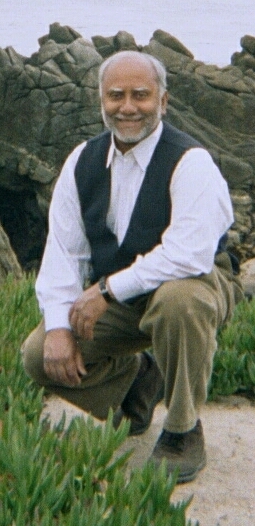Looking for Asia Beyond the Post-Colonial Stereotypes
New River Free Press International Presents
_____________________________________
SEEN & HEARD AT THE
ASIAN ART MUSEUM
CHONG-MOON LEE CENTER FOR
ASIAN ART AND CULTURE
The Softer Side of
Muslim Pilipino Culture
_________________________________
By Michael Chacko Daniels
MAGUI MORO MASTER ARTISTS On May 21, I got re-introduced to Filipino music through S. F.'s Asian Art Museum's AsiaAlive program, accidentally. I had gone with T. to re-examine the Ganesh statue at the portals of the museum's South Asia section, when we were stopped by the sounds of a man beating a gong in the museum's beautiful Samsung Hall. We sat enthralled for 15 minutes listening to the sounds produced with this simple instrument. The musician was a master artist performing Kulintang (gong ensemble) music.
The following Saturday, we attended an Islamic Filipino royal wedding performed by the Magui Moro Master Artists of the Philippines. This celebratory concert of Kulintang, dance, and rituals are part of the wedding traditions of the southern Philippines' Maguindanoan region. The packed audience of adults and children were regaled with music that was intended to evoke "typhoon rain, and crashing waves, leaping and prancing warriors, and mesmerizing incantations."
COMMENTARY My first introduction to the Muslim influence on Filipino music and dance was when I reviewed a performance of the Bayanihan Philippine Dance Company in San Francisco for The Asian Student [November 16, 1969], a former publication of The Asia Foundation. In that review, I praised the performance of the Bayanihan troupe for its grace and beauty, but had this comment:
"Most of the dancers and directors of the troupe [the Bayanihan troupe] are Christian, as is the Philippine nation. . .
"The dances of the Christian Filipinos were full of the joy of life; there was a charming softness to the graceful movements. This was in sharp contrast to the power and unsmiling, stately grace displayed in the Muslim dances.
"It reinforces the belief that the Bayanihan has yet to discover the full spirit of the Muslim Filipinos; and that the fear of the Muslim tribes, engendered in the Christian Filipinos by the Spaniards for four centuries, retains its hold, as can be seen in the emphasis in the Muslim dances on those traits that made the Christians fear the Muslims. However, it must be said that this is a cultural failing rather than an artistic one."
Watching and listening to the Magui Moro Master Artists at the Asian Art Museum in May 2005, I got some of the softness of Muslim Filipino culture that I missed 37 years ago in the Bayanihan dancers' performance, but not enough, which is more a comment on my preference for the softer side, even of warriors, than of anything else.
[USEFUL INFORMATION CULLED FROM THE MUSEUM'S PROGRAM NOTES MAGUI MORO MASTER ARTISTS: TENG EMBA--Kulintang (gong ensemble) musician; descended from a long line of Pilipino (Filipino) musicians; winner of the National Music Competition for Young Artists at age of six in 1982; joined Kalilangan Dance Company in 1999; he is in high demand for festivals and healing rituals. KARATUAN SANGKAY 'DATUAN' KALANDUYAN--Master of the kutiyapi (two-stringed lute), palending (flute), and gandingan ("talking" gongs); toured Asia, Europe, and North America; performed with Grace Nono, Lilang-Lilang Kulintang Ensemble, and others. DATU GUTIERREZ MANGANSAKAN II--Descended from Buayan and Maguindanao sultanates; filmmaker, writer, and scholar; winner of the 2001 Gawad CCP Independent Film Award for his film House Under the Crescent Moon. FAISAL MONAL--Master choreographer, dancer, musician; member of Salamindanao Dance Company, the Sining Kotawato Dance Group, and Bai Raquel Pandatum Magalona's Kalilangan Dance Troupe; winner of numerous street dancing championships. AKMAD SIAO--Master artist in Maguindanoan dance and music; winner of numerous street dancing competitions. YOLANDA MANGULAMAS--An expert in Maguindanoan culture, including cuisine, rituals, and indigenous practices; member of the Bangsa Moro. USEFUL INFORMATION ENDS]
The performance was co-sponsored by KulArts (www.kularts.org). KulArts was founded 20 years ago by Alleluia Panis, Marcella Pabros, and Robert Henry. According to the KulArts website, the organization's mission "is to inform and expand the understanding of American Pilipino culture through works that address contemporary issues in our community; to preserve the spirit and integrity of ancient Pilipino art forms; and to nurture the artistic development of Pilipino American artists." [May 31, 2005]
__________________________
You are invited to visit
New River Free Press International's
Career Visions for a Small PlanetCheck Out the Visions of
People Remaking Our Planet
Issue #1: Valerie Street
Issue #2: Hong Hunt
Issue #3: Ian C. Dawkins Moore
Issue #4: Peter Lee Kline
Issue #5: Ralph Dranow
Issue #6: Joseph Kaval
Issue #7: Quentine Acharya
Issue #8: Narendra Jadhav
Issue #9: Trash Pickers of Grand Rapids
Issue #10: Amanda Gerrie
And the following
Popular History Pages
/housing-conspiracies-michigan/
/open-housing-grand-rapids-1976/
/cities-survival-william-thrall/
/faith-society-father-ed-monroe/
/faith-society-praying-polish/
/zoo-cruelty-animals-michigan/
/food-coops-for-a-small-planet/
____________ * ____________
A Grand Rapids Popular History
Pages from New River Free Press, 1973 to 1977
Your Friendly Guide to Urban Survival & Improvement:
grhistory.blogspot.com/
An avid reader's comment about
Michael Chacko Daniels'
handcrafted books:
they look like little treasures."
--Brenda Coleman
a work of art in itself.


